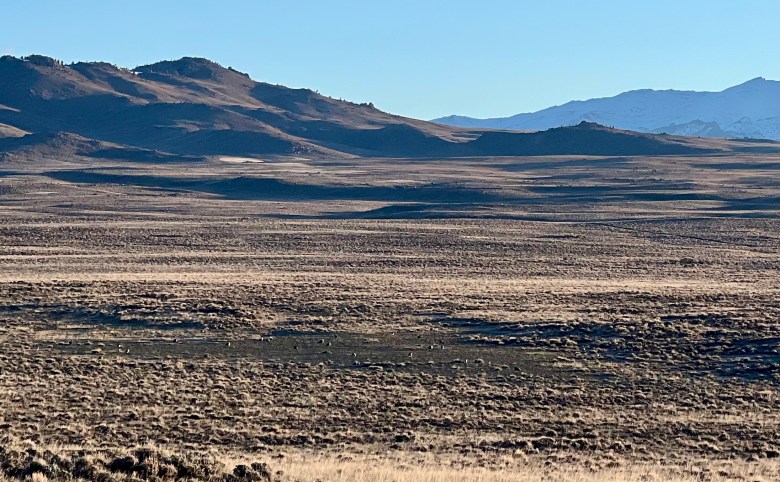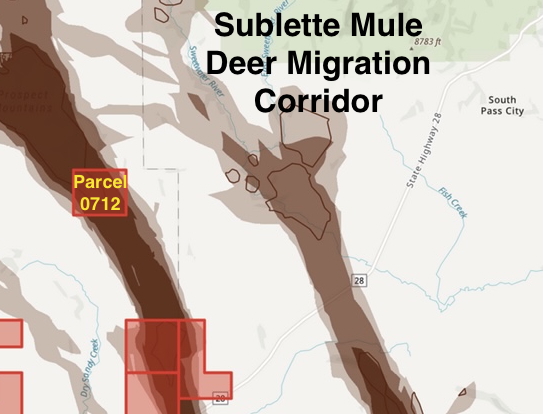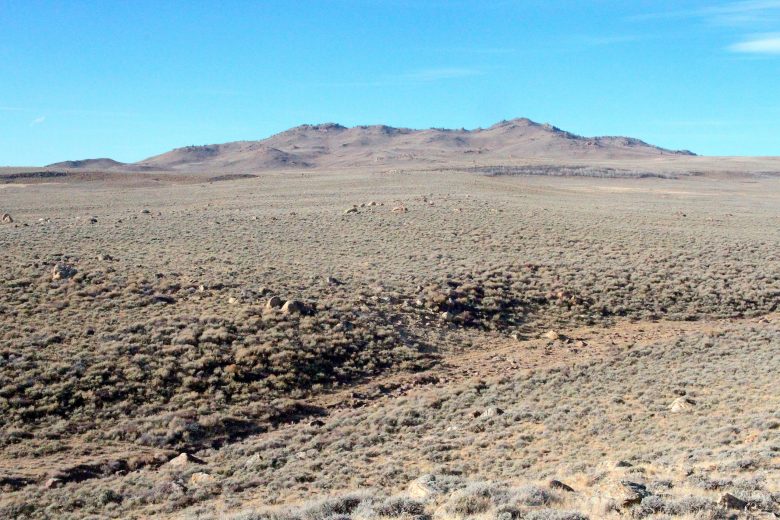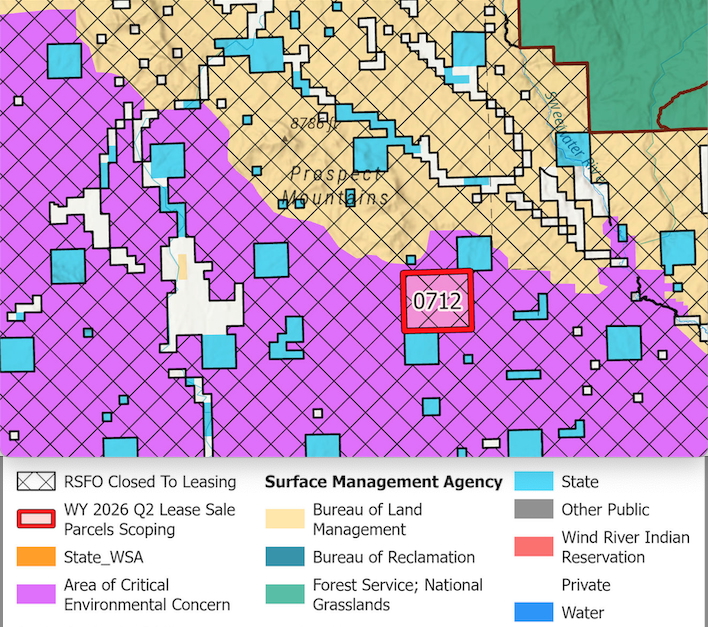The rolling, rockpile-strewn sagebrush that unfurls along more than 3 square miles of the Golden Triangle region appeared mostly devoid of life during a recent mid-November afternoon walk.
But brown, chalky spheres and cylinders of scat littering the landscape offered evidence of winged and hooved animals that call this ground home seasonally and throughout the year.
A mile or so southwest of the Lander Cutoff Road, this 2,194-acre Bureau of Land Management parcel is proposed for inclusion in an oil and gas lease sale set for June.
Wildlife biologists know the tract, labeled Parcel 0712 in the lease sale, as among the most biologically rich reaches of the sagebrush-steppe biome remaining anywhere on Earth.
Evidence of the claim is illustrated by the area’s abundance of greater sage grouse.
 Strutting male sage grouse gather on a portion of the Divide Lek, the world’s largest, in early May 2024. (Tom Christiansen)
Strutting male sage grouse gather on a portion of the Divide Lek, the world’s largest, in early May 2024. (Tom Christiansen)
Just two miles from the boundary of Parcel 0712 is the sprawling Divide Lek, which retired Wyoming sage grouse coordinator Tom Christiansen frequents in the spring. He’s there to count male birds strutting to court mates, and there are a ton of them.
“It’s the largest lek on the planet, at least that I’m aware of,” Christiansen said. “The highest [count] was over 300. I don’t remember the exact number, but this last year [the count] was over 200.”
Parcel 0712’s proximity to the largest-known congregation of sage grouse, a struggling species, isn’t the only superlative descriptor of its wildlife value. This parcel amid the sagebrush sea also completely overlaps the main thread of the longest mule deer migration corridor known to Wyoming and the world.
Discovered by biologist Hall Sawyer relatively recently in 2011, the route is used by thousands of mule deer headed to summer in the Hoback Basin, with the record setters even venturing as far as eastern Idaho. Come winter, the animals are found in the Red Desert and lower reaches of the Green River Basin. To get to and from their seasonal ranges, these ungulates travel a 100-plus miles, passing through the Prospect Mountains along the foot of the Wind River Range and right through the middle of Parcel 0712.
 The designated Sublette Mule Deer Migration Corridor, in brown, is intersected by 32 parcels totaling 38,727 acres that the Bureau of Land Management is proposing to auction during a June oil and gas lease sale. Labels have been superimposed by WyoFile. (Wyoming Outdoor Council)
The designated Sublette Mule Deer Migration Corridor, in brown, is intersected by 32 parcels totaling 38,727 acres that the Bureau of Land Management is proposing to auction during a June oil and gas lease sale. Labels have been superimposed by WyoFile. (Wyoming Outdoor Council)
Discussion is brewing in conservation circles about BLM’s proposed leasing of not just Parcel 0712, but tens of thousands of acres spread across five dozen parcels that intersect with Wyoming’s first three protected mule deer migration corridors. The lease auction set for June also could include tracts overlapping Wyoming’s first protected pronghorn corridor — a route that’s passed muster with state wildlife officials, but awaits a group of stakeholders and Gov. Mark Gordon’s approval.
All of the oil and gas leases slated for a June 2026 auction are in the early stages of the BLM’s vetting and approval process. Currently, they’re being “scoped,” subjected to public scrutiny and could still be pulled and never offered. Comments on the proposed parcels can be submitted online and are due by Monday. If they do get leased, an entirely separate environmental review process would await before approval is granted to actually drill.
Still, wildlife advocacy groups are questioning the wisdom of leasing the most vital sage grouse habitat remaining and areas in the middle of big game migration routes.
“Are we really okay with potentially sacrificing some of our most important wildlife habitat?” asked Alec Underwood, conservation director for the Wyoming Outdoor Council. “What kind of message does that send to all those who value wildlife and future generations?”
 The Prospect Mountains, center, rise to nearly 8,800 feet and mark the Continental Divide separating the Big Sandy and Sweetwater river drainages. This photo was taken from Parcel 0712, proposed for inclusion in the Bureau of Land Management’s June oil and gas lease sale. (Mike Koshmrl/WyoFile)
The Prospect Mountains, center, rise to nearly 8,800 feet and mark the Continental Divide separating the Big Sandy and Sweetwater river drainages. This photo was taken from Parcel 0712, proposed for inclusion in the Bureau of Land Management’s June oil and gas lease sale. (Mike Koshmrl/WyoFile)
But oil and gas companies that have fueled Wyoming’s economy and enabled the state to save and invest an extraordinary amount of money have a starkly different interpretation.
“There’s no place that I’m going to say is a place that shouldn’t be leased,” said Steve Degenfelder, a land manager for Kirkwood Oil and Gas, which is the primary company expressing interest in drilling the Golden Triangle region.
Degenfelder anticipates leases in the Golden Triangle will come with “extensive surface occupancy stipulations.” Those restrictions combined with modern drilling technology, he said, can help ensure that nesting sage grouse, migrating mule deer and other wildlife aren’t extensively harmed.
“I’m confident that the BLM land managers and Game and Fish can work with the operator, whoever that is, to mitigate [wildlife impacts],” Degenfelder said.
Another well-known Wyomingite whose ranch is right across the Lander Cutoff from Parcel 0712 said he’d need to learn more before passing judgement on the prospects of leasing and drilling an area that others consider ecologically sacred.
“Would I be supportive of anything they decided to do? Certainly not,” said Jim Magagna, a longtime livestock lobbyist. “But on the other hand, I’m very open minded about getting a better understanding of the development potential. What would it look like?”
 An oil and gas lease has been proposed for Parcel 0712, located within an area designated as off limits to leasing by the Bureau of Land Management’s Rock Springs Field Office. The parcel is within 2 miles of the world’s largest known sage grouse lek. (Bureau of Land Management)
An oil and gas lease has been proposed for Parcel 0712, located within an area designated as off limits to leasing by the Bureau of Land Management’s Rock Springs Field Office. The parcel is within 2 miles of the world’s largest known sage grouse lek. (Bureau of Land Management)
Without digging into his files, Degenfelder wasn’t sure if Kirkwood specifically nominated Parcel 0712. But the Casper-based company has long shown an interest in Golden Triangle-area parcels and it’s one of the outfits that has been leasing ground there for years over the objections of conservation groups. The nearly 20,000 Golden Triangle acres slated for auction in June were nominated in 2021, Degenfelder said. The parcels were initially going to be offered in June 2022, but then a consortium of environmental groups led by The Wilderness Society sued and were successful.
BLM’s proposal to lease the area again in 2025 is especially controversial because the standing federal land-use plan — the Biden-era Rock Springs Resource Management Plan — explicitly doesn’t allow it. Officials with the federal agency’s Wyoming office, who’ve been furloughed for weeks during the government shutdown, have been unreachable to explain the discrepancy, though notably, they’ve started the process of revising the current plan.
Degenfelder, meanwhile, points to President Donald Trump’s “national energy emergency” declaration as an explanation for BLM proposing to lease an area designated as off limits.
“It was similar to a War Powers Act,” he said of the declaration. “That could very well be the reason why.”
Others remain skeptical of leasing in the Golden Triangle. Christiansen, the former Game and Fish sage grouse corridor, said he’ll be watching to see how his old employer, the state of Wyoming, responds to BLM’s proposal.
“If the state chooses to support the lease sale, it puts public trust in state policies like the [sage grouse] executive order at risk, because they’re supporting an illegal action,” Christiansen said. “If we support actively disregarding the rule of law at the state level, the public can’t support or can’t trust state policy, either.”
During the 2019 debate over oil and gas leasing in the Golden Triangle, state wildlife officials did not advocate for “no surface occupancy” stipulations, pointing toward the state’s grouse policy, which they deemed adequate. Likewise, Wyoming’s ungulate migration policy also doesn’t call for no-disturbance stipulations outside of “bottlenecks” — and there are none in that portion of the designated Sublette Mule Deer Migration and proposed Sublette Pronghorn Migration.
 Tom Christiansen, Wyoming Game and Fish Department’s former sage grouse leader, checks out the habitat near the Divide Lek in 2015. Up to 300 male grouse strut in mating rituals in the spring at the site. (Angus M. Thuermer Jr./WyoFile)
Tom Christiansen, Wyoming Game and Fish Department’s former sage grouse leader, checks out the habitat near the Divide Lek in 2015. Up to 300 male grouse strut in mating rituals in the spring at the site. (Angus M. Thuermer Jr./WyoFile)
Although sage grouse were nowhere to be seen during WyoFile’s recent visit to Parcel 0712, that’s likely because the chicken-sized birds have reached the time of year when they are less dispersed, and instead concentrated in flocks that can number in the hundreds.
“They’re gathering now in their winter flocks,” Christiansen said. “It’s harder to find a group, but when you find a group, it’s going to be a lot larger.”
They’ll stay in the area of Parcel 0712, the adjacent record-setting Divide Lek and in the surrounding reaches of the best sagebrush habitat left on Earth, which are all part of a “broad winter complex,” the biologist said. Then come next spring — a month or two before the BLM’s planned lease sale — they’ll start strutting.
